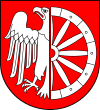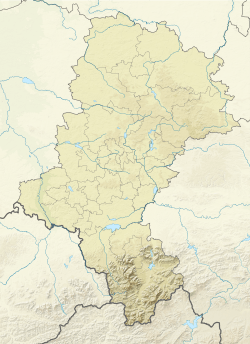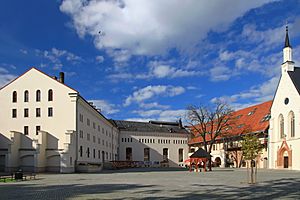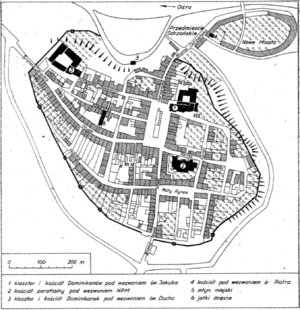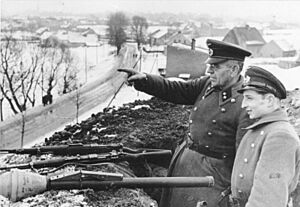Racibórz facts for kids
Quick facts for kids
Racibórz
|
|||
|---|---|---|---|

Former Holy Spirit Church, now a museum, 14th century
|
|||
|
|||
| Country | |||
| Voivodeship | |||
| County | Racibórz | ||
| Gmina | Racibórz (urban gmina) | ||
| First mentioned | 845 or 1108 | ||
| City rights | 1217 | ||
| Area | |||
| • Total | 74.96 km2 (28.94 sq mi) | ||
| Population
(31 December 2021)
|
|||
| • Total | 53,632 |
||
| Time zone | UTC+1 (CET) | ||
| • Summer (DST) | UTC+2 (CEST) | ||
| Postal code |
47-400 to 47-445
|
||
| Area code(s) | +48 32 | ||
| Car plates | SRC | ||
| National roads | |||
| Voivodeship roads | |||
| Website | www.raciborz.pl | ||
Racibórz is a city in southern Poland, located in the Silesian Voivodeship. It's the main town of Racibórz County. Racibórz is one of the oldest and most important cities in Upper Silesia.
From 1172 to 1521, Racibórz was the home of the Dukes of Racibórz. This made it a historic capital of Upper Silesia, along with the city of Opole.
Contents
Geography of Racibórz
Racibórz is located in the southwest part of the Silesian Voivodeship. It sits on the upper Oder river, close to the border with the Opole Voivodeship and the Czech Republic.
The area around Racibórz is called the Racibórz Basin. This basin is surrounded by mountains and uplands. The city center is about 75 kilometers (47 miles) southwest of Katowice. It is also about 160 kilometers (99 miles) southeast of Wrocław, which is a regional capital.
As of 2019, about 55,000 people live in Racibórz. From 1975 to 1998, the city was part of the Katowice Voivodeship.
History of Racibórz
Racibórz is one of the oldest towns in Upper Silesia. It was built on a hill fort where an old trade route crossed the Oder river. This route went from the Moravian Gate to Kraków.
Some historians think Racibórz might have been mentioned in a document from 845. This document talked about five strongholds of a Slavic tribe called the Golensizi. The name Racibórz comes from a Slavic language. It probably got its name from a duke named Racibor, who might have founded the city.
Racibórz in the Middle Ages
The first clear mention of Racibórz was in 1108. This was in a chronicle called Gesta principum Polonorum. At that time, the Polish duke Bolesław III Wrymouth was defending against attacks from Bohemia. Polish rule over Racibórz was confirmed in 1137. The city became part of the Duchy of Silesia in 1138.
Racibórz was famous for making beer. The townspeople had a special privilege to brew beer as early as the 12th century. Brewing beer was a big source of money for the town. Beer from Racibórz was popular in Silesia and nearby Czechia.
From 1155, Racibórz was an important administrative center. It became the first capital of Upper Silesia in 1172. This happened when Duke Mieszko I Tanglefoot created the Duchy of Racibórz. In 1202, Duke Mieszko ruled over all of Upper Silesia. He helped the town grow by inviting merchants from Flanders. In 1211, the first coin with the Polish word "MILOST" was made in Racibórz. In 1217, Duke Casimir I, Mieszko's son, gave Racibórz its city rights.
In 1241, Polish forces led by Duke Mieszko II the Fat won the Battle of Racibórz against the Mongols. Duke Mieszko founded a Dominican monastery in the city. He was buried there in 1246. The first Polish national anthem, Gaude Mater Polonia, was written around 1260–70 by a Dominican monk from the city.
In 1285, Duke Przemysław of Racibórz gave shelter to Bishop Thomas II Zaremba. In return, the Bishop founded a college of priests at Racibórz Castle. Duke Przemysław also started a Dominican nunnery. His daughter Euphemia became its first leader in 1313.
From 1299, Racibórz was governed by its own city council. This was based on the Magdeburg rights system. In 1327, Duke Leszek of Racibórz became a vassal of the Bohemian king. This meant his duchy became a part of the Kingdom of Bohemia. When Duke Leszek died in 1336 without heirs, Racibórz became a direct possession of the Bohemian king.
The next year, King John gave the duchy to Duke Nicholas II, Duke of Opava. From then on, Racibórz was ruled by a branch of the Bohemian Přemyslid dynasty. The citizens of Racibórz kept their self-governance. The town grew into an important center for trade. It had strong industries in cloth making, leather tanning, and brewing.
Racibórz in Modern Times
In 1521, the last duke from the Přemyslid family died. Racibórz then became part of the Duchy of Opole. Later, it became part of the lands ruled by the House of Habsburg. The city's economy suffered a lot during the Thirty Years' War. In 1683, Polish King John III Sobieski visited Racibórz on his way to the Battle of Vienna. He described it as a beautiful and fortified town.
After the First Silesian War in 1742, Racibórz became part of the Kingdom of Prussia. It was made the main town of a district in 1815. In the 19th century, Prussia tried to make the area more German. However, Polish people still lived there. In 1863, Poles secretly moved large amounts of gunpowder through Racibórz to help the January Uprising in Russian-controlled Poland. In 1871, Racibórz became part of the German Empire.
Racibórz in the 20th Century
In 1910, a census showed that about 60% of people in Racibórz spoke German, 30% spoke Polish, and 10% spoke both. After World War I, people in the area voted on whether to join Germany or Poland. In Racibórz town, 90.9% voted for Germany. So, the town stayed in Germany. However, the area east of the Oder river, which is now the Brzezie district, rejoined Poland.
Nazi Germany began to treat Polish activists badly from 1937. In 1939, German police searched Polish organizations and arrested their leaders. They also took over Polish buildings and confiscated Polish books.
During World War II, German forces entered Racibórz in September 1939. They arrested many important Poles. Throughout the war, the Germans ran prisons and forced labor camps in the town. These camps held Poles, Jews, and prisoners of war. In 1945, many prisoners were forced on long, deadly marches out of the town.
Racibórz was heavily damaged in March 1945 during the final stages of the war. After the war ended, in June 1945, the army of Czechoslovakia briefly entered the town. Czechoslovakia claimed the area because it had a Czech minority. At the same time, Germans living in the area were moved out. Racibórz then became part of Poland, as decided at the Potsdam Conference.
In 1997, a big flood hit Racibórz. Because of this, the Racibórz Dolny flood control reservoir was built nearby. It opened in 2020. This reservoir can hold a lot of water and cost about 2 billion zloty. It has been very important in protecting Racibórz and other cities like Opole and Wrocław from floods, including during the 2024 Central European floods.
Climate in Racibórz
Racibórz has a climate that is either considered oceanic climate or humid continental climate. This means it has moderate temperatures, with warm summers and cold winters. It gets a fair amount of rain throughout the year.
| Climate data for Racibórz (1991–2020 normals, extremes 1951–present) | |||||||||||||
|---|---|---|---|---|---|---|---|---|---|---|---|---|---|
| Month | Jan | Feb | Mar | Apr | May | Jun | Jul | Aug | Sep | Oct | Nov | Dec | Year |
| Record high °C (°F) | 14.2 (57.6) |
19.4 (66.9) |
24.3 (75.7) |
28.9 (84.0) |
32.3 (90.1) |
34.3 (93.7) |
36.2 (97.2) |
37.7 (99.9) |
34.7 (94.5) |
26.6 (79.9) |
21.7 (71.1) |
17.3 (63.1) |
37.7 (99.9) |
| Mean daily maximum °C (°F) | 1.9 (35.4) |
3.8 (38.8) |
8.4 (47.1) |
15.1 (59.2) |
19.6 (67.3) |
22.9 (73.2) |
25.4 (77.7) |
25.3 (77.5) |
19.7 (67.5) |
14.0 (57.2) |
8.1 (46.6) |
3.0 (37.4) |
13.9 (57.0) |
| Daily mean °C (°F) | −0.9 (30.4) |
0.3 (32.5) |
4.0 (39.2) |
9.4 (48.9) |
13.9 (57.0) |
17.3 (63.1) |
19.2 (66.6) |
19.0 (66.2) |
14.2 (57.6) |
9.4 (48.9) |
4.8 (40.6) |
0.4 (32.7) |
9.3 (48.7) |
| Mean daily minimum °C (°F) | −3.7 (25.3) |
−2.8 (27.0) |
0.2 (32.4) |
4.0 (39.2) |
8.5 (47.3) |
11.9 (53.4) |
13.4 (56.1) |
13.2 (55.8) |
9.5 (49.1) |
5.7 (42.3) |
2.0 (35.6) |
−2.1 (28.2) |
5.0 (41.0) |
| Record low °C (°F) | −29.7 (−21.5) |
−28.8 (−19.8) |
−23.2 (−9.8) |
−6.2 (20.8) |
−2.6 (27.3) |
0.5 (32.9) |
4.8 (40.6) |
2.9 (37.2) |
−2.7 (27.1) |
−7.2 (19.0) |
−15.6 (3.9) |
−27.1 (−16.8) |
−29.7 (−21.5) |
| Average precipitation mm (inches) | 27.2 (1.07) |
25.1 (0.99) |
31.4 (1.24) |
36.8 (1.45) |
68.2 (2.69) |
77.9 (3.07) |
90.7 (3.57) |
69.3 (2.73) |
63.3 (2.49) |
46.7 (1.84) |
38.1 (1.50) |
30.1 (1.19) |
604.8 (23.81) |
| Average extreme snow depth cm (inches) | 6.7 (2.6) |
6.2 (2.4) |
3.1 (1.2) |
1.1 (0.4) |
0.0 (0.0) |
0.0 (0.0) |
0.0 (0.0) |
0.0 (0.0) |
0.0 (0.0) |
0.2 (0.1) |
2.0 (0.8) |
3.8 (1.5) |
6.7 (2.6) |
| Average precipitation days (≥ 0.1 mm) | 15.03 | 13.52 | 13.89 | 11.50 | 13.83 | 13.53 | 14.20 | 11.93 | 11.80 | 12.83 | 13.63 | 14.10 | 159.80 |
| Average snowy days (≥ 0 cm) | 14.9 | 13.3 | 5.5 | 0.9 | 0.0 | 0.0 | 0.0 | 0.0 | 0.0 | 0.2 | 3.6 | 9.4 | 47.8 |
| Average relative humidity (%) | 84.9 | 82.2 | 77.3 | 71.2 | 73.7 | 75.3 | 73.7 | 73.4 | 79.1 | 82.7 | 85.9 | 86.2 | 78.8 |
| Mean monthly sunshine hours | 47.1 | 67.0 | 116.0 | 179.8 | 220.7 | 224.1 | 240.7 | 235.2 | 153.4 | 107.4 | 56.7 | 41.4 | 1,689.5 |
| Source 1: Institute of Meteorology and Water Management | |||||||||||||
| Source 2: Meteomodel.pl (records, relative humidity 1991–2020) | |||||||||||||
City Districts
Racibórz is divided into several districts:
- Centrum
- Nowe Zagrody
- Ocice
- Stara Wieś
- Miedonia
- Ostróg
- Markowice
- Płonia
- Brzezie
- Sudół
- Studzienna
- Obora
Culture in Racibórz
Racibórz is known for its traditional local beer. This beer is officially protected as a special regional product in Poland. It comes in different styles and is a part of the city's heritage.
Sports in Racibórz
The main men's football team in Racibórz is KP Unia Racibórz. They play in the lower leagues now, but they used to play in Poland's top division.
There was also a very successful women's football club called RTP Unia Racibórz. This team played in Poland's top women's league. They won the national championship five times in a row from 2009 to 2013.
Famous People from Racibórz
Many notable people have come from Racibórz, including:
- Joseph Freiherr von Eichendorff (1788–1857), a Prussian poet and playwright.
- Ludwig Traube (1818–1876), a German physician.
- Moritz Traube (1826–1894), a German chemist.
- Else Berg (1877–1942), a German-Dutch painter.
- Augustin Souchy (1892–1984), a German anarchist writer.
- Hubert Kostka (born 1940), a famous footballer.
- Ryszard Wolny (born 1969), an Olympic champion wrestler.
- Magdalena Walach (born 1976), an actress.
- Rafał Brzoska (born 1977), an entrepreneur who founded InPost.
- Artur Noga (born 1988), an athlete.
- Justyna Święty-Ersetic (born 1992), a sprinter.
Twin Towns and Sister Cities
Racibórz has "twin town" or "sister city" relationships with several cities around the world. These partnerships help promote cultural exchange and friendship.
 Kędzierzyn-Koźle, Poland
Kędzierzyn-Koźle, Poland Leverkusen, Germany
Leverkusen, Germany Opava, Czech Republic
Opava, Czech Republic Roth, Germany
Roth, Germany Tysmenytsia, Ukraine
Tysmenytsia, Ukraine Villeneuve-d'Ascq, France
Villeneuve-d'Ascq, France Zugló (Budapest), Hungary
Zugló (Budapest), Hungary
Racibórz used to be twinned with Kaliningrad, Russia. However, this partnership ended in 2022 due to the Russian invasion of Ukraine.
Images for kids
See also
 In Spanish: Racibórz para niños
In Spanish: Racibórz para niños



